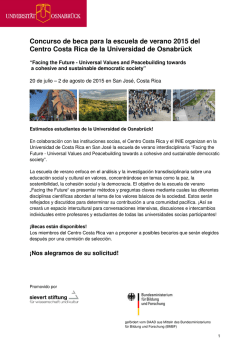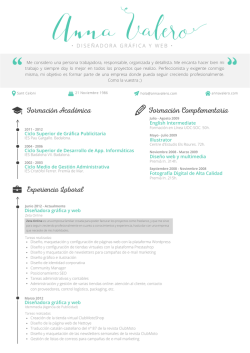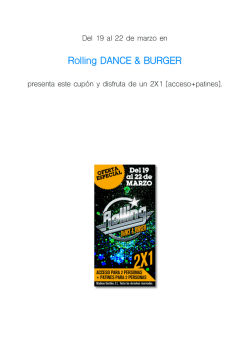
Presentación Plenaria - Bettina Burger Menzel
De la innovación hacia un sistema de innovación. Qué actores necesita un modelo exitoso? Prof. Dr. Bettina Burger-Menzel Universidad de Ciencias Aplicadas de Brandenburgo (THB) Sesión junto con Prof. Dr. Juan Manuel Corona & Prof. Dr. Manuel Soria López Universidad Autónoma Metropolitana – Xochimilco (UAM-X) Conferencia DAAD Alumni, Ciudad de México / 18.06.2016 1 Sistemas de Innovación son estructuras y flujos interrelacionados sistemas de innovación y sus actores Un sistema de innovación (SI) es un sistema de instituciones y organizaciones interconectadas para crear, almacenar, transferir y adaptar conocimientos, habilidades y equipos que definen nuevas tecnologías. sistema de educación y investigación sector productivo grandes empresas maduros PMEs actores de transferencía de tecnología (Basado en Metcalfe 1995) Instituciones= Sistemas de incentivos formales e informales. Burger-Menzel (2011) nuevos empresas (start-ups, spin-offs) professional education & training educación superior universitaria con investigación Burger-Menzel politicas burocratas institutos de investigación sociedad público general; grupos de interés demanda consumidores (B2C); productores (B2B) Organizaciones= Estructura en que se asocien (grupos de) individuales. gobierno Graph: Burger-‐Menzel (2011) Fachhochschule Brandenburg · University of Applied Sciences Seite Gráfica: Burger-‐Menzel (2011) Burger-‐Menzel / THB Ciudad de México 18.06.2016 2 Aprendizaje en sistemas de innovación requiere capacidades e infraestructura Aprendizaje en sistemas de innovación tiene precondiciones para ser efectivo, por ejemplo: • Capacidad de absorción y de crea9vidad (p. ej. sistema de educación, redes de aprendizaje... ) -‐> educaPon index; innovaPon index • Infraestructura para trabajar con conocimientos (p .ej. capital de riesgo, oportunidad digital, acesso a los TICs...) -‐> InformaPon and communicaPon technology index h"ps://knowledgemaze.files.wordpress.com/ 2015/10/k:indeces.png< Gráfica: knowledgemaze.files.wordpress.com/ 2015/10/k-‐indeces.png Burger-‐Menzel / THB Ciudad de México 18.06.2016 3 Sistemas de Innovación y sus caracteristicas La pregunta ‚adaptada‘ de la plenaria: Cuáles son los factores claves para un sistema exitoso de innovación? Burger-‐Menzel / THB Ciudad de México 18.06.2016 4 Factor clave 1: Un modelo exitoso requiere una diversidad de actores ! Diversos actores pracPcan una división de trabajo enfocándose en lo que es la competencia clave de cada uno que incluye competencias para • crear, The network case of biodiversity Provider communities Supporting networks (traditional, incl. indigenous) (financial and legal firms, lobby organizations) User groups (Business-to-business; businessto-customer) • almacenar, • transferir y Biotechindustry • adaptar conocimientos, habilidades y equipos que definen nuevas tecnologías (comparar con definición SI). (multinational, national companies) Research networks Societal groups (universities,research institutes) Public authorities (International organizations; national, regional, local authorities) (non-governmental organizations, voters) Gráfica: Burger-‐Menzel (2016) en base de Geels (2002) Burger-‐Menzel / THB Ciudad de México 18.06.2016 5 )J7A;>EB:;HIÞ?DÞ;HC7DÞH;I;7H9>Þ<KD:?D=Þ 7BIEÞB;7:IÞJEÞ;NJ;DI?L;Þ;DJ7D=B;C;DJIÞ?DÞJ>;ÞÏD7D9?D=Þ7D:Þ ?CFB;C;DJ7J?EDÞE<ÞH;I;7H9>ÞFHE@;9JIÞ)K9>Þ9ECFB;C;DJ7HOÞ 7D:Þ9EEF;H7J?L;ÞIJHK9JKH;IÞ97DÞ8;ÞH;=7H:;:Þ7IÞIJHED=Þ;L? :;D9;ÞE<Þ7ÞIEF>?IJ?97J;:Þ7D:Þ:?L;HI;Þ(ÞB7D:I97F;ÞJ>7JÞKD <EB:IÞ?JIÞ<KBBÞFEJ;DJ?7BÞ?DÞ9EEF;H7J?EDÞM?J>ÞJ>;ÞF7HJ?9?F7DJIÞ ?=KH;ÞÛÞ?BBKIJH7J;IÞJ>;Þ9>7H79J;HÞ7D:Þ<KD:?D=ÞE<ÞJ>;Þ;HC7DÞ H;I;7H9>ÞB7D:I97F;Þ ?=KH;ÞÛÞ Caso de Alemania: División de trabajo en el sistema de innovación *>;Þ;HC7DÞH;I;7H9>ÞB7D:I97F;Þ R&D expenditure in billions of Euros (2007) Ciencia aplicada (Þ;NF;D:?JKH;Þ?DÞ8?BB?EDIÞE<Þ;KHEIÞÖÔÔÛÞ:7J7Þ FFB?;:ÞH;I;7H9> ?=ÞÛÞ #&Þ %J>;HÞ -"Þ H7KD>E<;H;I;BBI9>7<JÞ ;HC7DDÞLEDÞ;BC>EBJPÞ ;C;?DI9>7<J #7N&B7D9A;I;BBI9>7<J DEDFHEÏJÞI9?;DJ?Ï9Þ?DIJ?JKJ?EDIÞ FH;:EC?D7DJBOÞ<KD:;:ÞD;?J>;HÞ8OÞ J>;ÞIJ7J;ÞDEHÞ?D:KIJHOÞ -?II;DI9>7<JI=;C;?DI9>7<JÞ EJJ<H?;:Þ-?B>;BCÞ";?8D?P Ciencia básica 7I?IÞE<Þ:7J7ÞJ78B;IÞÕÞ7D:ÞÖÜÞ )EKH9;Þ#Þ,,*Þ &K8B?9ÞI;9JEHÞ ?DIJ?JKJ?EDIÞ Õ×Þ ÔÝÞ ÖÛÞ Õ×Þ #&Þ KD:7C;DJ7BÞH;I;7H9>Þ >Þ Þ (;I;7H9>Þ9>7H79J;HÞ Ø×ÔÞ Ô×Þ ÕÔÞ > -"Þ %J>;H D:KIJHO ÝÝÞ +D?L;HI?J?;IÞ )9?;DJ?Ï9ÞB?8H7H?;IÞ 7H9>?L;IÞCKI;KCIÞ &K8B?9Þ ÕÔÞ *EJ7BÞ;NF;D:?JKH;Þ ÖÔÔÛÞÚÕÙÞ8?BB?EDÞ;KHEIÞ KD:?D= &H?L7J;Þ Gráfica: BMBF y VDI-‐VDE-‐IT en BMBF (2010) Burger-‐Menzel / THB Ciudad de México 18.06.2016 6 Caso de Alemania: Polí9cas para es9mular redes de aprendizaje y innovación estatal federal Graph: VDI/VDE Prof. Dr. Burger-Menzel / copyright Burger-‐Menzel / THB Ciudad de México 18.06.2016 124 Gráfica: VDI/VDE InnovaPon + Technik GmbH (2012) 7 Factor clave 2: Cada sistema de innovación necesita su proprio modelo ! communication,On%nodes%(actors)%and%5es% advise, trust networks (rela5onships)% Las condiciones de cada sistema de innovación son específicas (historía, economía, cultura...), especialmente cuando hay diversidad de actores. instrumental, affective, moral ties Prof. Dr. Burger-Menzel / copyright 39 Example:% UN% Conven5on% on% Biological% Diversity% and% its% follow?up% Nagoya% P (Quota5on%from%the%Australian%Government‘s%online%factsheet):%% „The% Austrailian% Government% is% consul5ng% with% the% res community,% indigenous% people,% industry% partners% and% stat territory% governments% to% find% the% best% way% to% implemen [Nagoya]%Protocol%in%Australia."% Burger-‐Menzel / THB Ciudad de México 18.06.2016 % Burger?Menzel%*%Senior%Fellow%KHK/GCR21%&% 8 sentliche Teile der regionalen Netze fehlen. In den Regionen Dresden und Jena trifft dies auch auf eine Reihe außeruniversitärer öffentlicher Forschungseinrichtungen zu, wie z. B. die Fraunhofer-Institute. Die Fachhochschulen sind ebenfalls in den Innovationsnetzwerken präsent, allerdings ist ihre Patentaktivität aufgrund der im Vergleich zu Universitäten deutlich geringeren Forschungskapazitäten relativ schwach ausgeprägt. Allgemein sind die öffentlichen Forschungseinrichtungen in allen Regionen zentraler positioniert als die privaten Akteure, und zwar in doppeltem Sinne: Zum einen besitzen sie eine größere Anzahl direkter Beziehungen zu ihrem Umfeld. Zum anderen nehmen sie häufiger als private Patentanmelder eine potenzielle Brokerfunktion zwischen anderen Akteuren wahr, d. h. der Pfad zwischen zwei beliebigen Akteuren im Netzwerk führt häufiger über öffentliche Forschungseinrichtungen als über private Akteure. FH Jena Jenaer Glas Caso de Alemania: Redes de innovación por patentes registrados (1995-‐2001) Dresden Das Netzwerk der Patentanmelder in der Region Dresden 1995-2001 Agfa Halle Das Netzwerk der Patentanmelder in der Region Halle 1995-2001 BSW Ingenieurbüro Ardenne Institut FH Merseburg Institut für Polymerforschung Forsch.zentr. Rossendorf Fraunhofer Hermsdorfer Inst. f. Technische Keramik Daimler Bosch TU Dresden Infineon Siemens MUEG HTW Dresden Inst. f. Werkstofftechnik KataLeuna MLU Halle König&Bauer AG Institut für Luftu. Kältetechnik SynTec Feinchemie FEW LeunaWerke Chemtec Leuna Paraffinwerk Case Hans-KnöllInstitut Krupp Thür. Inst. für Textilu. Kunststoffforsch. Buna Sow Leuna Sanierungsges. Wolfen Inofex Haack 15 Gráficas: Fritsch, Henning, Slavtchev, Steigenberger (2007) Ingenieurtechnik u. Maschinenbau Schott inocermi c Tridelta Burger-‐Menzel / THB Ciudad de México 18.06.2016 Carl Zeiss Anemometerbau BioServ Biomun 9 Factor clave 3: Un modelo exitoso maneja bien la interdisciplinariedad! How(to(integrate(crea<vity(into(NIS(policies?( Burger<Menzel!(2011);!fig.!see!Burger<Menzel!/!Assadi!(2012),!p.256! ! Es importante de codesarrollar aprendizaje entre disciplinas como: • • • • • • • Ciencias naturales Ingenería Antropología y linguística Sociología Economía Ciencías políticas Psicología macro% psychology%of%socie5es% social%acceptance%(norms,% rules,%customs,%culture,%…)% group%behaviour% social%acceptance%(leadership% culture%and%%organisa5onal% culture,%…)% micro% • ... mo5va5onal%factors%for% innova5ve%behaviour% na5onal%systems%of%innova5on% condi5ons%and%situa5ve%op5ons% (infrastructure,%public%policies,%…)% mesoeconomic%environment%% condi5ons%and%situa5ve%op5ons% (market%condi5ons,%resources%of% network,%regional%features,%…)% from%crea5vity%to%an% innova5ve%„take%off“% individual%willingness%(desire,% need,%…)%&%individual%capability% (competences,%…)% Gráfica: Burger-‐Menzel y Assadi (2012) Burger-‐Menzel / THB Ciudad de México 18.06.2016 10 Factor What is culture? Culture is learned and neither a personality trait nor something that we h mon as human nature and therefore share with all mankind. As Hofstede et al. (Hofstede, G G. J., Minkov, M. (2010): p. 6) differentiate: (i) human nature is universal as well as inheri clave 4: Un model exitoso incorpora cognición, cultura y comunicación! sonality is specific to an individual as well as inherited and learned; (iii) culture is specifi or category as well as learned within different contexts. Such a context can be an individua in family, peer groups, regional or national clusters and then expressed as values, ri Towards&a&cogni8ve&human&being:&Mental&modes&and&their&cultu orientation and symbols, thereby resulting in differentiated individual practices (compare fi • Es importante de entender cómo el ser humano toma decisiones y actúa. • En sistemas de innovación que incluyen diversas disciplinas y culturas, se aumenta el riesgo de ruido en el canal de comunicación. Symbols( PERSO7 NALITY( CULTURE' Heroes( Rituals( Values( ( es 4c c a Pr Values:' Individual( Family' (((((Group' ( Regional' Na2onal' Others( HUMAN( NATURE( Figure 2.!The “Onion”: Manifestations of Culture at Different Burger,Menzel&and&Syring&(2013:&20)&with&own&adapta8on&of&Hofstede&et&al.&(20 Levels of Depth. Own adaption from Hofstede, et al., 2010: p. 6-10 Thus, there are different layers that can powerfully shape a person’s behavior, also within How can we cope with such a cultural reality in innovation and team management? Gráfica: Burger-‐Menzel y Syring (2013) „No!two!individuals!have!exactly!the!same!experiences!and!accor basado en Hofstede et al. (2010) mental!models!would!tend!to!diverge!if!there!were!not!ongoing!c Burger-‐Menzel / THB 3 DEVELOPMENT 11 AND Ciudad de México 18.06.2016 OF TEAMS – THEORETICAL APPROACHES PRACTICAL RECOMMENDATIONS with!other!individuals!with!a!similar!cultural!background!...!The!c Factor clave 5: Un modelo exitoso entiende como funcionan redes informales! Es importante de entender redes informales • para lograr con innovación y aprendizaje (= flujos de información, de consejos y de Formal networks actividades que establecen confianza); • para facilitar oportunidades experimentales (= reducir el riesgo de ‚path-dependency‘). & En un mundo de complejidad, dinámica y disrupción se tiene que adaptar Informal networks: What is the ‚story‘ • sistemas de incentivos behind an organizational • organizaciones y procesos chart? • prácticas para reciprocidad • ... Cross!et!al.!(2003)! Copyright&Burger,Menzel& 33& Gráfica: Cross et al. (2013) Burger-‐Menzel / THB Ciudad de México 18.06.2016 12 Factor clave 6: Un modelo exitoso es sostentable! Es importante de incluir temas de innovación social y de servicios ecológicos para poder cambiar el paradigma tecnológico existente. netposiLve.worldpress.com< Foto: netpositive.worldpress.com Burger-‐Menzel / THB Ciudad de México 18.06.2016 13 Bibliograba BMBF (2010): Federal Report on Research and InnovaPon 2010, Bonn, Berlin, June Burger-‐Menzel, B. (2016): Environmental poliPcs and the human being: A new interdisciplinary perspecPve on moPvaPonal processes and sustainable change behavior, KHK-‐GCR Research Paper, Käte Hamburger Kolleg / Centre for Global CooperaPon Research, University Duisburg-‐ Essen, Duisburg Burger-‐Menzel, B. (2011): Creators and NaPonal InnovaPon Systems: How to Integrate MoPvaPonal Factors into Policy ConsideraPons, in: Aboites, J., Corona, J. M. (eds.), Economía de la Innovación y Desarollo, Mexico-‐City, S.267-‐285 Burger-‐Menzel, B. / Syring, N. (2013): Managing across cultures – How to posiPvely impact innovaPon through diversity, in: Hofstadler, H., Wiesinger, S., Gaisch, M., Überwimmer, M., Spitzer, A. (eds.), Cross Cultural Conference 2013 -‐ Proceedings, Steyr, 17-‐26 Burger-‐Menzel, B. / Assadi, S. (2012): The economics of open sourcing: A new type of interacPve learning within naPonal innovaPon systems, Ide@s CONCYTEG, 7 (80), S. 240-‐260 Cross, R. / Parker, A. / Sasson, L. (2003): Networks in a Knowledge Society, Oxford University Press, Oxford Fritsch, M. / Henning, T. / Slavtchev, V. / Steigenberger, N. (2008): Hochschulen als regionaler InnovaPonsmotor?, Hans Böckler SPtung, Düsseldorf Geels, F. W. (2002), Technological transiPons as evoluPonary reconfiguraPon processes: a mulP-‐level perspecPve and a case-‐study, Research Policy, 31, 1257-‐1274 Hofstede, G. / Hofstede, G. J. / Minkow, M (2009): Cultures and OrganizaPons, New York Metcalfe, S. (1995): The Economic FoundaPons of Technology Policy: Equilibrium and EvoluPonary PerspecPves, in: Stoneman, P. (ed.), Handbook of the Economics of InnovaPon and Technological Change, Oxford University Press, Oxford VDI/VDE InnovaPon + Technik GmbH (2012): Überblick über clusterpoliPsche Maßnahmen auf Länder-‐ und Bundesebene, November, hwp:// www.agitano.com/wp-‐content/uploads/2013/01/VDI-‐VDE-‐InnovaPon.jpg …muchas gracias por su atención! Burger-‐Menzel / THB Ciudad de México 18.06.2016 15
© Copyright 2025




